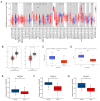The Ion Channel Gene KCNAB2 Is Associated with Poor Prognosis and Loss of Immune Infiltration in Lung Adenocarcinoma
- PMID: 36359834
- PMCID: PMC9653610
- DOI: 10.3390/cells11213438
The Ion Channel Gene KCNAB2 Is Associated with Poor Prognosis and Loss of Immune Infiltration in Lung Adenocarcinoma
Abstract
The malignancy with the greatest global mortality rate is lung cancer. Lung adenocarcinoma (LUAD) is the most common subtype. The evidence demonstrated that voltage-gated potassium channel subunit beta-2 (KCNAB2) significantly participated in the initiation of colorectal cancer and its progression. However, the biological function of KCNAB2 in LUAD and its effect on the tumor immune microenvironment are still unknown. In this study, we found that the expression of KCNAB2 in tissues of patients with LUAD was markedly downregulated, and its downregulation was linked to accelerated cancer growth and poor clinical outcomes. In addition, low KCNAB2 expression was correlated with a deficiency in immune infiltration. The mechanism behind this issue might be that KCNAB2 influenced the immunological process such that the directed migration of immune cells was affected. Furthermore, overexpression of KCNAB2 in cell lines promoted the expression of CCL2, CCL3, CCL4, CCL18, CXCL9, CXCL10, and CXCL12, which are necessary for the recruitment of immune cells. In conclusion, KCNAB2 may play a key function in immune infiltration and can be exploited as a predictive biomarker for evaluating prognosis and a possible immunotherapeutic target.
Keywords: KCNAB2; chemokine; immune infiltration; immunotherapy; lung adenocarcinoma.
Conflict of interest statement
The authors declare no conflict of interest.
Figures









Similar articles
-
Increased expression of TTC21A in lung adenocarcinoma infers favorable prognosis and high immune infiltrating level.Int Immunopharmacol. 2020 Jan;78:106077. doi: 10.1016/j.intimp.2019.106077. Epub 2019 Dec 5. Int Immunopharmacol. 2020. PMID: 31812070
-
Heat shock factor 5 correlated with immune infiltration serves as a prognostic biomarker in lung adenocarcinoma.Int J Med Sci. 2021 Jan 1;18(2):448-458. doi: 10.7150/ijms.51297. eCollection 2021. Int J Med Sci. 2021. PMID: 33390814 Free PMC article.
-
Prognostic value and immune infiltration of a novel stromal/immune score-related P2RY12 in lung adenocarcinoma microenvironment.Int Immunopharmacol. 2021 Sep;98:107734. doi: 10.1016/j.intimp.2021.107734. Epub 2021 Jun 25. Int Immunopharmacol. 2021. PMID: 34175738
-
Pan-Cancer Analysis of Immune Cell Infiltration Identifies a Prognostic Immune-Cell Characteristic Score (ICCS) in Lung Adenocarcinoma.Front Immunol. 2020 Jun 30;11:1218. doi: 10.3389/fimmu.2020.01218. eCollection 2020. Front Immunol. 2020. PMID: 32714316 Free PMC article.
-
NPM1 Is a Prognostic Biomarker Involved in Immune Infiltration of Lung Adenocarcinoma and Associated With m6A Modification and Glycolysis.Front Immunol. 2021 Jul 16;12:724741. doi: 10.3389/fimmu.2021.724741. eCollection 2021. Front Immunol. 2021. PMID: 34335635 Free PMC article.
Cited by
-
Role of pyroptosis-related cytokines in the prediction of lung cancer.Heliyon. 2024 May 15;10(10):e31399. doi: 10.1016/j.heliyon.2024.e31399. eCollection 2024 May 30. Heliyon. 2024. PMID: 38813211 Free PMC article.
-
Potassium Ion Channels in Glioma: From Basic Knowledge into Therapeutic Applications.Membranes (Basel). 2023 Apr 15;13(4):434. doi: 10.3390/membranes13040434. Membranes (Basel). 2023. PMID: 37103862 Free PMC article. Review.
-
Ion channels in lung cancer: biological and clinical relevance.Front Pharmacol. 2023 Oct 24;14:1283623. doi: 10.3389/fphar.2023.1283623. eCollection 2023. Front Pharmacol. 2023. PMID: 37942486 Free PMC article. Review.
-
Identification and validation of ion channels-related mRNA prognostic signature for glioblastomas.Medicine (Baltimore). 2024 Nov 29;103(48):e40736. doi: 10.1097/MD.0000000000040736. Medicine (Baltimore). 2024. PMID: 39612412 Free PMC article.
-
KCNAB2 overexpression inhibits human non-small-cell lung cancer cell growth in vitro and in vivo.Cell Death Discov. 2023 Oct 19;9(1):382. doi: 10.1038/s41420-023-01679-5. Cell Death Discov. 2023. PMID: 37852974 Free PMC article.
References
Publication types
MeSH terms
Substances
LinkOut - more resources
Full Text Sources
Other Literature Sources
Molecular Biology Databases
Research Materials

